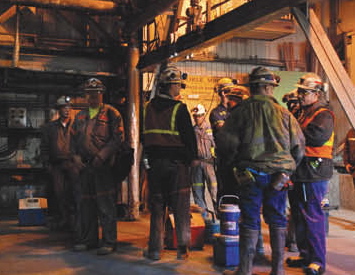White Pine County received a Christmas present this week with the Bureau of Land Management– 500 jobs.
According to a press release the federal agency Midway Gold’s Pan Mine located about 50 miles west of Ely or 22 miles southeast of Eureka. project received the go ahead December 20th.
The decision allows the mining operator to construct and operate a new heap leach gold mine that would consist of two primary open pits, three satellite pits, one heap leach pad, three rock disposal areas and a transmission line. The total surface disturbance would be approximately 3,301 acres.
 According to BLM project manager Dan Netcher the proposed mine will employ some 500 workers in its combined construction and extraction phases
According to BLM project manager Dan Netcher the proposed mine will employ some 500 workers in its combined construction and extraction phases
The life of the mine is initially projected to last a decade.
“Mine life is always hard to predict,” Netcher added. “A lot depends on the price of gold and of course how much gold is found.”
When mining first began on the Carlin Trend in the 1960’s, for example, it was then predicted that the ore would last some 15 or 20 years. Almost 50 years later the mines are still going strong as the deposits continue to confound experts.
 Once through the regulatory and permitting process work at the mine site could begin as early as late 2014 or early 2015 which is also the time the Long Canyon mine located between Wendover and Wells in the Pequops Mountains is also expected to beginning construction.
Once through the regulatory and permitting process work at the mine site could begin as early as late 2014 or early 2015 which is also the time the Long Canyon mine located between Wendover and Wells in the Pequops Mountains is also expected to beginning construction.
Environmental concerns for both projects are however considered minimal. The open pit of the gold Rock Mine is to be built on the open pit of the Easy Junior and the Long Canyon however appears to be almost free and clear or any concerted green opposition. The Nevada Sierra Club was barely aware of the project as was its sister organization in Utah.
 While both projects are located near “historical” trailways such as the Pny Express and portions of the California trail, opposition to them from pioneer groups has been negligible.
While both projects are located near “historical” trailways such as the Pny Express and portions of the California trail, opposition to them from pioneer groups has been negligible.
“There are markers and monuments along the way,” said BLM spokesman Chris Hanefield. “I imagine those historical groups are satisfied.”
One of the reason for this lack of interest may imply be the fact that Long Canyon is in the sweetest of sweet spots of any mine in recent history.
In addition to being having ‘smoking hot’ ore the area is a stones throw from Interstate 80, has no endangered species living anywhere near it and does not have any significant archeological sites located on it.
 That is however not true for another proposed mine site located less than 20 miles north of Wendover.
That is however not true for another proposed mine site located less than 20 miles north of Wendover.
Last month the BLM denied a request for a mining claim from Mesa mining. The $85 million proposed potash would have meant up to 40 long term high paying jobs . While the plant was to be located on the wasteland of the Salt Flats a wagon train historical group mobilized to keep the mine and its jobs from ever becoming realized because what could be 150 year old wagon ruts could still be present in the area near the mine site.
 “I’ve seen this same story reported in a number of publications and I just want to set the record straight regarding the misleading historical information it contains. There were a lot more than four wagon trains that used the Hastings Cutoff. Maybe there were four in the same the year (1846) the Donners used the trail, but it continued to be used until at least 1850. I think in 1850 alone about 12 trains used it.” Wrote one anti-potash works blogger. “…When profit is the motivation, land and the “little” people are paid lip-service and are ultimately exploited. Learn from your history folks, don’t just blindly chase the almighty dollar.”
“I’ve seen this same story reported in a number of publications and I just want to set the record straight regarding the misleading historical information it contains. There were a lot more than four wagon trains that used the Hastings Cutoff. Maybe there were four in the same the year (1846) the Donners used the trail, but it continued to be used until at least 1850. I think in 1850 alone about 12 trains used it.” Wrote one anti-potash works blogger. “…When profit is the motivation, land and the “little” people are paid lip-service and are ultimately exploited. Learn from your history folks, don’t just blindly chase the almighty dollar.”
The irony that those pioneers were in fact also chasing the almighty as they sprinted across the Hastings Cutoff to make it to the gold fields of California seemed to escape the writer.


